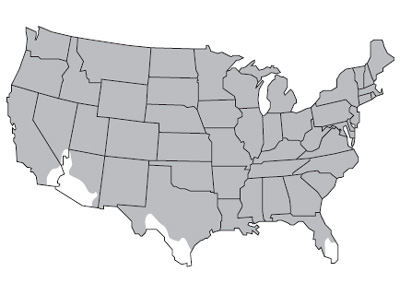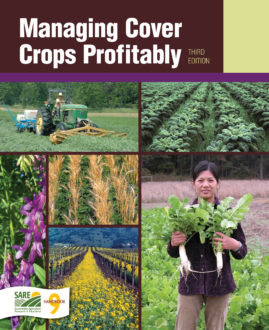Barley (Hordeum vulgare)

Type: cool season annual cereal grain
Roles: prevent erosion, suppress weeds, scavenge excess nutrients, add organic matter
Mix with: annual legumes, ryegrass or other small grains
See charts for ranking and management summary.
Inexpensive and easy to grow, barley provides exceptional erosion control and weed suppression in semi-arid regions and in light soils. It also can fill short rotation niches or serve as a topsoil- protecting crop during droughty conditions in any region. It is more salt tolerant than other small grains and can sop up excess subsoil moisture to help prevent saline seep formation (136).
It’s a fine choice for reclaiming overworked, weedy or eroded fields, or as part of a cover crop mix for improving soil tilth and nutrient cycling in perennial cropping systems in Hardiness Zone 8 or warmer.

Barley prefers cool, dry growing areas. As a spring cover crop, it can be grown farther north than any other cereal grain, largely because of its short growing period. It also can produce more biomass in a shorter time than any other cereal crop (273).
Benefits of Barley Cover Crops
Erosion control. Use barley as an overwintering cover crop for erosion control in Zone 8 and warmer, including much of California, western Oregon and western Washington. It’s well-suited for vineyards and orchards, or as part of a mixed seeding.
As a winter annual, barley develops a deep, fibrous root system. The roots can reach as deep as 6.5 feet. As a spring crop, barley has a comparatively shallow root system but holds soil strongly to minimize erosion during droughty conditions (71).
Nutrient recycler. Barley can scavenge significant amounts of nitrogen. It captured 32 lb. N/A as a winter cover crop following a stand of fava beans (Vicia faba) in a California study, compared with 20 lb./A for annual ryegrass. A barley cover crop reduced soil N an average of 64 percent at eight sites throughout North America that had received an average of 107 lb. N/A (265). Intercropping barley with field peas (Pisum sativum) can increase the amount of N absorbed by barley and returned to the soil in barley residue, other studies show (215, 218). Barley improves P and K cycling if the residue isn’t removed.
Weed suppressor. Quick to establish, barley outcompetes weeds largely by absorbing soil moisture during its early growing stages. It also shades out weeds and releases allelopathic chemicals that help suppress them.
Tilth-improving organic matter. Barley is a quick source of abundant biomass that, along with its thick root system, can improve soil structure and water infiltration (273, 445). In California cropping systems, cultivars such as UC476 or COSINA can produce as much as 12,900 lb. biomass/A.
Nurse crop. Barley has an upright posture and relatively open canopy that makes it a fine nurse crop for establishing a forage or legume stand. Less competitive than other small grains, barley also uses less water than other covers crops. In weedy fields, wait to broadcast the forage or legume until after you’ve mechanically weeded barley at the four or five-leaf stage to reduce weed competition.
As an inexpensive, easy-to-kill companion crop, barley can protect sugarbeet seedlings during their first two months while also serving as a soil protectant during droughty periods (details below).
Pest suppression. Barley can reduce incidence of leafhoppers, aphids, armyworms, root-knot nematodes and other pests, a number of studies suggest.
Management of Barley Cover Crops
Establishment and Fieldwork for Barley Cover Crops
Barley establishes readily in prepared seedbeds, and can also be successfully no-tilled. It prefers adequate but not excessive moisture and does poorly in waterlogged soils. It grows best in well-drained, fertile loams or light, clay soils in areas having cool, dry, mild winters. It also does well on light, droughty soils and tolerates somewhat alkaline soils better than other cereal crops.
With many varieties of barley to choose from, be sure to select a regionally adapted one. Many are well-adapted to high altitudes and cold, short growing seasons.
Spring annual use. Drill at 50 to 100 lb./A (1 to 2 bushels) from 3/4 to 2 inches deep into a prepared seedbed, or no-till using the same seeding rate.
If broadcasting, prepare the seedbed with at least a light field cultivation. Sow 80 to 125 lb./A (1.5 to 2.5 bushels) and harrow, cultipack or disk lightly to cover. Use a lower rate (25 to 50 pounds) if overseeding as a companion crop or a higher rate (140 pounds) for very weedy fields. When broadcasting, consider seeding half in one direction, then the rest in a perpendicular direction for better coverage (71).
Winter annual use. Barley can be used as a winter annual cover crop wherever it is grown as a winter grain crop. It is less winter-hardy than rye. In Zone 8 or warmer, it grows throughout the winter if planted from September through February. Plantings before November 1 generally fare best, largely due to warmer soil conditions.
Expect mixed results if trying to use barley as a self-reseeding cover crop.
Mixed seedings. Barley works well in mixtures with other grasses or legumes. In low-fertility soils or where you’re trying to minimize tie-up of soil nitrogen, growing barley with one or more legumes can be helpful. Your seeding cost per pound will increase, but the reduced seeding rate can offset some of this. A short-season Canadian field pea would be a good companion, or try an oat/barley/pea mix, suggests organic farmer Jack Lazor, Westfield, Vt.
In northern California, Phil LaRocca (LaRocca Vineyards, Forest Ranch, Calif.) lightly disks his upper vineyard’s soil before broadcasting a mix of barley, fescue, brome, LANA vetch, and crimson, red and subterranean clovers, usually during October. He seeds at 30 to 35 lb./A, with 10 to 20 percent being barley. “I’ve always added more barley to the seeding rate than recommended. More is better, especially with barley, if you want biomass and weed suppression,” he says.
After broadcasting, LaRocca covers erosion prone areas with 2 tons of rice straw per acre, which is “cheaper than oat straw here and has fewer weed seeds,” he notes. “The straw decomposes quickly and holds seed and soil well.” Besides contributing to soil humus (as the cover crop also does), the straw helps keep the seedbed warm and moist. That can be very helpful in LaRocca ’s upper vineyard, where it sometimes snows in winter.
In his other, less-erodible vineyard, LaRocca disks up the cover vegetation, then runs a harrow quickly on top of the disked alleyways to set a seedbed before broadcasting and cultipacking a similar mix of cover crops.
Field Management for Barley Cover Crops
Although barley absorbs a lot of water in its early stages, it uses moisture more efficiently than other cereals and can be grown without irrigation in some situations. About half of the commercial barley acreage in dryland areas is irrigated, however. California cropping systems that include barley tend to be irrigated as well. Low seeding rates won’t necessarily conserve moisture, as vegetative growth often increases.
LaRocca hasn’t had any moisture problems or grape-yield concerns from growing barley or other cover crops, even in the 40 percent of his upper vineyard that isn’t furrow-irrigated. “Once your vines are established, their root system is deeper and much more competitive than a typical cover crop’s root system,” he observes.
Mowing can postpone and prolong barley flowering, as with other cereal grains. As a spring cover, barley puts on biomass quickly, so you can kill it in plenty of time for seeding a following crop. If you want barley to reseed, don’t mow until most of the stand has headed and seed is about to fall off.
To encourage reseeding of his cover mix, Phil LaRocca allows every other row in his upper vineyard to go to seed, then disks it down. That lets him skip reseeding some blocks.
If you’re concerned about barley reseeding or crop competition when intercropped, however, plant a lighter stand, suggests Alan Brutlag, Wendell, Minn. During droughty conditions, he broadcasts 25 to 30 pounds of barley per acre as a soil-protective companion crop for sugarbeet seedlings. The low-density stand is easy to stunt or kill a month later with the combination of herbicides and crop oil that he uses for weed control in his sugarbeets. Another control option is a single application of an herbicide labeled for grass control.
Killing & Controlling Barley Cover Crops
Kill barley with a grass herbicide in late spring, or by rolling disking or mowing at the mid- to latebloom stage but before it starts setting seed.
If plant-parasitic nematodes have been a problem, incorporate overwintered barley early in spring, before warm temperatures encourage nematode populations.
Pest Management for Barley Cover Crops
Annual weeds and lodging can occur when growing barley in high-fertility soils, although these wouldn’t pose problems in a barley cover crop. Despite their less dense canopy, six-rowed varieties tend to be taller and more competitive against weeds than two-rowed varieties. If you’re considering a grain option, harrowing or hoeing just before barley emergence could reduce weeds that already have sprouted.
Barley produces alkaloids that have been shown to inhibit germination and growth of white mustard (247). These exudates also protect barley plants from fungus, armyworm larvae, bacteria and aphids (248, 455).
Barley seems to reduce the incidence of grape leafhoppers in vineyards and increase levels of beneficial spiders, one California grower observed (211). Growing high-biomass cover crops such as barley or rye increased populations of centipedes, predator mites and other important predators, independent of tillage system used, a study in the Pacific Northwest found (444).
Cutworms and other small grain pests can be occasional problems. Some perennial crop growers in California report increased incidence of gophers when growing cover crop mixes and try to minimize this by encouraging owl populations.
Avoid seeding in cold, damp soils, which makes barley more prone to fungus and disease. Assuming adequate soil moisture, shallow seeding can hasten emergence and lessen incidence of root rot disease, if this has been a problem in your area (397). Varieties resistant to leaf diseases are available. Two-rowed varieties are more resistant to leaf rust and mildew. Also avoid planting barley after wheat.
If nematodes are likely to be a problem, plant late in fall or during winter to avoid warm-season growth and incorporate early in spring in Zone 8 and warmer. Barley can be a host for a nematode species (Meloidogyne javanica) that adversely affects Thompson seedless grapes.
Barley drastically reduced root-knot nematode (Meloidogyne hapla M. Chitwood) populations and increased marketable carrot yields by at least seventeen-fold in a Quebec study comparing three-year rotations (242).
Other Options for Barley Cover Crops
Barley can be grazed lightly in winter or spring or cut for hay/haylage (191). It has greater forage nutritive value than oats, wheat or triticale. It also can be grown as a specialty grain for malting, soups, bread and other uses. As a feed grain (in a hog ration, for example), it can replace some costlier corn.
Comparative Notes
- Barley tillers more than oats and also is more drought-tolerant, but oats generally perform better as a companion crop or winterkilled nurse crop because they are less competitive than barley (397).
- Barley tolerates alkaline soils better than any other cereal.
- Winter cultivars are less winterhardy than winter wheat, triticale or cereal rye.
Cultivars. Many commercial varieties are available. Look for low-cost, regionally adapted cultivars with at least 95-percent germination.
Six-rowed cultivars are better for overseeding, and are more heat- and drought-tolerant. Two-rowed types have more symmetrical kernels and are more disease-resistant (e.g. leaf rust and mildew) than six-rowed types, in which two-thirds of the lateral rows of the spike are smaller and twisted.
